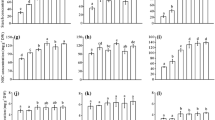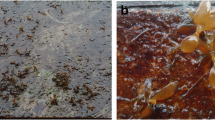Abstract
Growth, chemical composition, and nitrate reductase activity (NRA) of hydroponically cultured Rumex crispus, R. palustris, R. acetosa, and R. maritimus were studied in relation to form (NH4 +, NO3 -, or both) and level of N supply (4 mM N, and zero-N following a period of 4mM N). A distinct preference for either NH4 + or NO3 - could not be established. All species were characterized by a very efficient uptake and utilization of N, irrespective of N source, as evident from high concentrations of organic N in the tissues and concurrent excessive accumulations of free NO3 - and free NH4 +. Especially the accumulation of free NH4 + was unusually large.
Generally, relative growth rate (RGR) was highest with a combination of NH4 + and NO3 -. Compared to mixed N supply, RGR of NO3 -- and NH4 +-grown plants declined on average 3% and 9%, respectively. Lowest RGR with NH4 + supply probably resulted from direct or indirect toxicity effects associated with high NH4 + and/or low Ca2+ contents of tissues. NRA in NO3 - and NH4NO3 plants was very similar with maxima in the leaves of ca 40 μmol NO2 - g-1 DW h-1. ‘Basal’ NRA levels in shoot tissues of NH4 + plants appeared relatively high with maxima in the leaves of ca 20 μmol NO2 - g-1 DW h-1. Carboxylate to organic N ratios, (C-A)/Norg, on a whole plant basis varied from 0.2 in NH4 + plants to 0.9 in NO3 - plants.
After withdrawal of N, all accumulated NO3 - and NH4 + was assimilated into organic N and the organic N redistributed on a large scale. NRA rapidly declined to similar low levels, irrespective of previous N source. Shoot/root ratios of -N plants were 50–80% lower than those from +N plants. In comparison with +N, RGR of -N plants did not decline to a large extent, decreasing by only 15% in -NH4 + plants due to very high initial organic-N contents. N-deprived plants all exhibited an excess cation over anion uptake (net proton efflux), and whole-plant (C-A)/Norg ratios increased to values around unity.
Possible difficulties in interpreting the (C-A)/Norg ratio and NRA of plants in their natural habitats are briefly discussed.
Similar content being viewed by others
References
Allen S and Smith J A C 1986 Ammonium nutrition in Ricinus communis: Its effect on plant growth and the chemical composition of the whole plant, xylem and phloem saps. J. Exp. Bot. 37, 1599–1610.
Allen S, Raven J A and Thomas G E 1985 Ontogenetic changes in the chemical composition of Ricinus communis grown with NO3 - or NH4 + as N source. J. Exp. Bot. 36, 413–425.
Barker A V and Mills H A 1980 Ammorium and nitrate nutrition of horticultural crops. Hortic. Rev. 2, 395–423.
Barker A V, Volk R J and Jackson W A 1966 Root environment acidity as a regulatory factor in ammonium assimilation by the bean plant. Plant Physiol. 41, 1193–1199.
Barker A V, Maynard D N and Lachman W H 1967 Induction of tomato stem and leaf lesions, and potassium deficiency, by excessive ammonium nutrition. Soil Sci. 103, 319–327.
Blacquière T, Hofstra R and Stulen I 1987 Ammonium and nitrate nutrition in Plantago lanceolata and Plantago major L. ssp. major. I. Aspects of growth, chemical composition and root respiration. Plant and Soil 104, 129–141.
Bloom A J 1988 Ammonium and nitrate as nitrogen sources for plant growth. ISI Atlas of Science, Animal and Plant Sciences, pp 55–59.
Engelaar W M H G, Bodelier P L E, Laanbroek H J and Blom C W P M 1991 Nitrification in the rhizospere of a flooding-resistant and a flooding-non-resistant Rumex species under drained and waterlogged conditions. FEMS Microbiol. Ecol. 86, 33–42.
Gebauer G, Melzer A and Rehder H 1984 Nitrate content and nitrate reductase activity in Rumex obtusifolius L. I. Differences in organs and diurnal changes. Oecologia 63, 136–142.
Gebauer G, Rehder H and Wollenweber B 1988 Nitrate, nitrate reduction and organic nitrogen in plants from different ecological and taxonomic groups of central Europe. Oecologia 75, 371–385.
Gigon A and Rorison I H 1972 The response of some ecologically distinct plant species to nitrate- and to ammonium-nitrogen. J. Ecol. 60, 93–102.
Givan C V 1979 Metabolic detoxification of ammonia in tissues of higher plants. Phytochemistry 18, 375–382.
Hageman R H and Below F E 1990 Role of nitrogen metabolism in crop productivity. In Nitrogen in Higher Plants. Ed. Y P Abrol. pp 313–334. Wiley, New York.
Havill D C, Lee J A and Stewart G R 1974 Nitrate utilization by species from acidic and calcareous soils. New Phytol. 73, 1221–1231.
Jaworski E G 1971 Nitrate reductase assay in intact plant tissues. Biochem. Biophys. Res. Comm. 43, 1274–1279.
Lee J A and Stewart G R 1978 Ecological aspects of nitrogen assimilation. Adv. Bot. Res. 6, 2–43.
Maynard D N and Barker A V 1969 Studies on the tolerance of plants to ammonium nutrition. J. Am. Soc. Hort. Sci. 94, 235–239.
Melzer A, Gebauer G and Rehder H 1984 Nitrate content and nitrate reductase activity in Rumex obtusifolius L. II. Responses to nitrate starvation and nitrogen fertilization. Oecologia 63, 380–385.
Millard P 1988 The accumulation and storage of nitrogen by herbaceous plants. Plant, Cell Environ. 11, 1–8.
Oaks A, Stulen I and Boesel I L 1979 Influence of amino acids and ammonium ions on nitrate reduction in corn seedlings. Can. J. Bot. 57, 1824–1829.
PatrickJr W H and Mikkelsen D S 1971 Plant nutrient behavior in flooded soil. In Fertilizer Technology and Use, 2nd edition. Eds. R A Olson, T J Army, J J Hanway and V J Kilmer. pp 187–215. SSSA, Madison, WI.
Rajasekhar V K and Oelmüller R 1987 Regulation of induction of nitrate reductase and nitrite reductase in higher plants. Physiol. Plant. 71, 517–521.
Raven J A 1985a Regulation of pH and generation of osmolarity in vascular plants: A cost-benefit analysis in relation to efficiency of use of energy, nitrogen and water. New Phytol. 101, 25–77.
Raven J A 1985b pH regulation in plants. Sci. Prog. Oxf. 69, 495–509.
Raven J A and Smith F A 1976 Nitrogen assimilation and transport in vascular land plants in relation to intracellular pH regulation. New Phytol. 76, 415–431.
Reddy K S and Menary R C 1990 Nitrate reductase and nitrate accumulation in relation to nitrate toxicity in Boronia megastigma. Physiol. Plant. 78, 430–434.
Rowell D L 1981 Oxidation and reduction. In The Chemistry of Soil Processes. Eds. D J Greenland and M H B Hayes. pp 401–461. Wiley, New York.
Srivastava H S 1980 Reulgation of nitrate reductase activity in higher plants. Phytochemistry 15, 725–733.
Tolley-Henry L and RaperJr C D 1986 Utilization of ammonium as a nitrogen source: Effects of ambient acidity on growth and nitrogen accumualtion by soybean. Plant Physiol. 82, 54–60.
Troelstra S R 1983 Growth of Plantago lanceolata and Plantago major on a NO3/NH4 medium and the estimation of the utilization of nitrate and ammonium from ionic balance aspects. Plant and Soil 70, 183–197.
Troelstra S R, VanDijk C and Blacquière T 1985 Effects of N source on proton excretion, ionic balance and growth of Alnus glutinosa (L) Gaertner: Comparison of N2 fixation with single and mixed sources of NO3 and NH4. Plant and Soil 84, 361–385.
Troelstra S R, Wagenaar R and Smant W 1992 Growth of actinorhizal plants as influenced by the form of N with special reference to Myrica gale and Alnus incana. J. Exp. Bot 43, 1349–1359.
Troelstra S R, Blacquière T, Wagenaar R and VanDijk C 1987 Ionic balance, proton efflux, nitrate reductase activity and growth of Hippophaë rhamnoides L. ssp. rhamnoides as influenced by combined-N nutrition or N2 fixation. Plant and Soil 103, 169–183.
Voesenek L A C J 1990 Adaptations of Rumex in Flooding Gradients. Ph.D. Thesis, Catholic University, Nijmegen, The Netherlands.
Wollenweber B and Kinzel H 1988 Role of carboxylate in the nitrogen metabolism of plants from different natural habitats. Physiol. Plant. 72, 321–328.
Author information
Authors and Affiliations
Rights and permissions
About this article
Cite this article
Langelaan, J.G., Troelstra, S.R. Growth, chemical composition, and nitrate reductase activity of Rumex species in relation to form and level of N supply. Plant Soil 145, 215–229 (1992). https://doi.org/10.1007/BF00010350
Received:
Issue Date:
DOI: https://doi.org/10.1007/BF00010350




